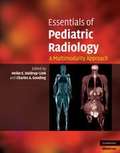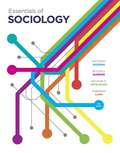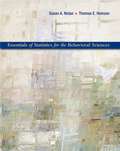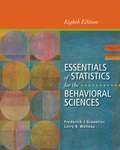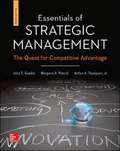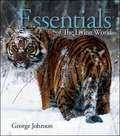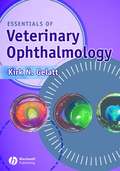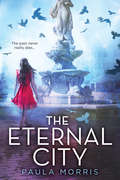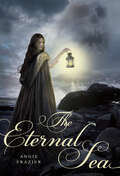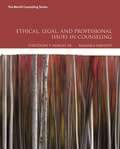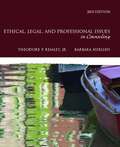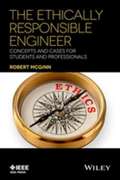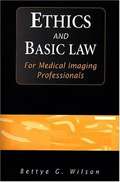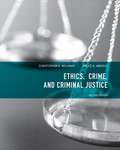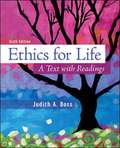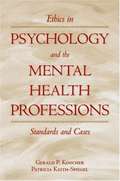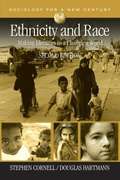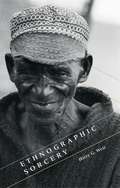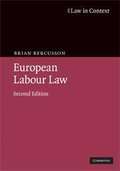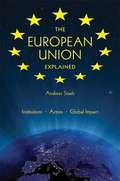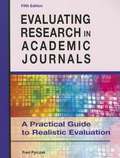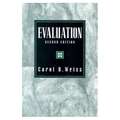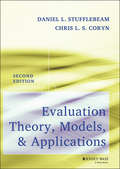- Table View
- List View
Essentials of Pediatric Radiology
by Heike E. Daldrup-Link Charles A. GoodingEssentials of Pediatric Radiology: A Multimodality Approach provides a concise overview of both basic and complex topics encountered by pediatric radiologists in their daily practice. Written by leading pediatric radiologists from renowned children's hospitals, it focuses particularly on multimodality imaging, covering the full gamut of radiologic diagnostic techniques, including conventional radiography and ultrasound, Doppler ultrasound, up-to-date CT and MRI techniques, and PET-CT. Each chapter is generously illustrated with high quality images, as well as graphs, tables, decision flowcharts and featured cases. Chapters are arranged according to pathologies, rather than organ systems, providing the reader with clinically-oriented information when employing 'whole body' techniques or analysing scans involving multiple anatomical sites. The book is complemented by online presentations of cases as 'unknowns', which enable readers to test their diagnostic proficiency. A key text for pediatric radiology fellows, radiology residents and general radiologists, this is also essential reading for all pediatricians.
Essentials of Real Estate Investment
by David SirotaIt is with this positive point of view that this ninth edition of Essentials of Real Estate Investment was prepared: with an eye to our imminent financial recovery and to prepare the reader for the time when investing in real estate will again emerge as a rational and profitable alternative to build a valuable inheritable estate.
Essentials of Sociology (Fourth Edition)
by Anthony Giddens Mitchell Duneier Richard P. Appelbaum Deborah CarrThis is a textbook that teaches students how issues in our global society connect to their own lives.
Essentials of Statistics for the Behavioral Sciences
by Susan Nolan Thomas HeinzenEssentials of Statistics for the Behavioral Sciences by Susan Nolan and Thomas Heinzen is a concise, readable text that covers key statistical concepts. Exploring its wide variety of creative, step-by-step examples, students using Essentials will learn how to choose the appropriate statistical test, understand its conceptual significance, and calculate each statistic. With inviting examples using real-world data, the text teaches students to apply concepts and formulas to statistical questions that they will encounter in their academic lives and outside the classroom. The clear, accessible explanations highlight a conceptual understanding of statistics that minimize the mathematical. Nolan and Heinzen's brief text also provides the most opportunities for students to evaluate their understanding, with three tiers of exercises --Clarifying the Concepts, Calculating the Statistic, and Applying the Concepts-- integrated after each major topic as well as at the end of each chapter.
Essentials of Statistics for the Behavioral Sciences (8th Edition)
by Frederick J Gravetter Larry B. WallnauThe goal of this book is not only to teach the methods of statistics but also to convey the basic principles of objectivity and logic that are essential for science and valuable for decision making in everyday life.
Essentials of Strategic Management: The Quest for Competitive Advantage (Fourth Edition)
by John E. Gamble Arthur A. Thompson Margaret A. PeterafThe text presents a conceptually strong treatment of strategic management principles and analytic approaches that features straight-to-the-point discussions and timely examples.
Essentials of Surgical Pediatric Pathology
by Marta C. Cohen Irene ScheimbergEssentials of Surgical Pediatric Pathology is a clear and practical yet comprehensive guide for trainee pediatric pathologists and non-pediatric pathologists.
Essentials of the Living World 4th Edition
by George B. JohnsonEssentials of The Living World is often considered a student favorite. George Johnson has written this non-majors textbook from the ground up to be an engaging and accessible learning tool with an emphasis on "how things work and why things happen the way they do". Essentials of The Living World focuses on concepts rather than terminology and technical information, and features a straightforward, clear writing style and a wide variety of media assets to enhance the content of the textbook.
Essentials of Veterinary Ophthalmology (Second Edition)
by Kirk N. GelattNow in its second edition, Essentials of Veterinary Ophthalmology provides its readers with a practical introduction to the diagnosis and clinical management of the most frequently encountered eye diseases of domestic animals. Essentials of Veterinary Ophthalmology is distilled from the authoritative, two-volume, fourth edition of Veterinary Ophthalmology (Gelatt), drawing primarily on the clinically relevant sections to provide expert coverage in a more concise and quick-reference format - ideal for busy small animal or equine practitioners seeking rapid advice for a patient. The second edition includes more images, algorithms to speed the clinical problem-solving process, key points highlighted in bold, expanded appendices for convenient reference to therapeutic agents, recommended dosages, and possible side effects, and a brief glossary.Practical and accessible, the second edition of Essentials of Veterinary Ophthalmology is filled with reader-friendly features to provide veterinary students and practitioners with an indispensable resource for the fundamentals of clinical veterinary ophthalmology.* Focuses on the most common eye diseases of small animals and horses* Provides expert coverage in a concise, quick-reference format* New edition includes more images, algorithms, key points in bold, expanded appendices and glossary* Based on the two-volume definitive reference Veterinary Ophthalmology, 4th Edition (Gelatt)
The Eternal City
by Paula MorrisFrom master of suspense Paula Morris comes a tale of gods and goddesses, thrilling romance, and mystery set in present-day Rome.Laura Martin is visiting Rome on a class trip, and she's entranced by the majestic Colosseum, the Trevi Fountain, the Pantheon . . . Everything in this city seems magical. That is, until the magic seems to turn very dark. Suddenly, statues of Cupid and ancient works of art come to life before her eyes. Earthquakes rumble and a cloud of ash forms in the sky. A dark-eyed boy with wings on his heels appears and gives her a message. Laura soon realizes she is at the center of a brewing battle -- a battle between the gods and goddesses, one that will shake modern-day Rome to its core. Only she and her group of friends can truly unravel the mystery behind what is happening. As tensions mount and secret identities are revealed, Laura must rely on her own inner strength to face up to what may be a fight for her life. Acclaimed author Paula Morris brings the ancient world to vivid life in this unstoppable tale of friendship, love, and the power of the past.
The Eternal Sea
by Angie FrazierRomance and adventure are just around the corner . . .After the thrilling journey that led Camille through the dangerous discovery of love, secrets, and a magical stone that grants immortality, Camille has everything she wants. She's escaped the men who wanted her dead, and now she is ready to build a new life with Oscar, her one true love. But things are not to be so simple. Oscar is acting strangely, and before they can even board a ship from Australia back home, to San Francisco, Camille learns that the journey is not over. If she does not follow the magic of the curse of Umandu, her life and Ocar's could be in grave danger.
Ethical, Legal, and Professional Issues in Counseling
by Theodore P. Remley Barbara HerlihyThis authoritative resource, written by two counseling professors--one an attorney and the other an expert in ethics--explores the most difficult ethical, legal, and professional challenges in counseling in an easy-to-understand manner. Ideal for instructors who do not specialize in the topics presented, and for students who are learning about the counseling profession, Ethical, Legal, and Professional Issues in Counseling includes numerous case studies throughout not only to highlight difficult situations faced by counselors, but also to give readers the benefit of the authors' best thinking on how to resolve the dilemmas. The complex legal, ethical, and professional counseling issues are analyzed and discussed in a manner that allows counselors to resolve challenging situations as they arise in their practice. Included is practical advice on how to manage ethical and legal issues such as using technology and social media, counseling minors and vulnerable adults, counseling clients who may be suicidal or violent, responding to subpoenas; setting boundaries with clients, students, and supervisees serving as gatekeepers for the counseling profession; developing a private practice, responding to complaints, and practicing in a diversity-sensitive manner. The topics are relevant for school counselors, clinical mental health counselors, college counselors, rehabilitation counselors, marriage and family counselors, substance abuse counselors, and counselors who practice in other specialties. As a text it is appropriate for undergraduate, master's level, and doctoral level human services and counseling.
Ethical, Legal, and Professional Issues in Counseling (3rd Edition)
by Barbara Herlihy Theodore P. Remley Jr.For undergraduate and graduate courses in Counseling Ethics, Legal Issues in Counseling; a supplement for Introduction to Counseling, Practicum, or Internship courses. From two leading scholars in the field of counseling, and written specifically for the future practicing counselor, this comprehensive volume offers an in-depth examination of the counseling profession. The authors approach each professional issue in counseling from both an ethicalanda legal point-of-view, offering readers a complete, integrated exploration of all facets. Difficult issues are addressed in a straightforward manner, and practical, realistic advice is proffered through vignettes that showcase typical situations and dilemmas faced by practicing counselors.
The Ethically Responsible Engineer: Concepts and Cases for Students and Professionals
by Robert McginnThe book lays out and discusses four Fundamental Ethical Responsibilities of Engineers (FEREs) that are incumbent of engineers. It also shows how the FEREs can be applied to particular engineering situations to determine specific "derivative ethical responsibilities" that are incumbent on engineers in those situations Includes a variety of case studies in various fields of engineering that are divided into four parts: salient factual background, ethical issues, analysis of ethical issues, and moral lessons Grasp ethical issues in real-life situations The author is a professor of Management Science and Engineering and Science, Technology, and Society (STS) at Stanford University
Ethics and Basic Law for Medical Imaging Professionals
by Bettye G. WilsonComplies with ASRT curriculum guidelines requiring coverage of ethical theory, behavior, and dilemmas; legal responsibilities; and patient consent. Provides coverage of special issues, such as the impaired colleague and special patient populations, including the terminally ill patient and the patient with an infectious disease. Discussion questions facilitate classroom discussion and student analysis. Each chapter includes objectives and an end-of-chapter summary.
Ethics, Crime, and Criminal Justice (Second Edition)
by Christopher R. Williams Bruce A ArrigoThis comprehensive, provocative text meaningfully examines ethical theories and their application to current issues, controversies, and professional scenarios in law, crime, and justice. It introduces students to the foundations of the study of ethics and morality; examines prominent moral and ethical themes, conflicts, and struggles in criminology and criminal justice; and explores the conceptual and practical value of key ethical concepts, principles, and arguments. This edition is extensively updated and revised for greater clarity, cohesiveness, and accessibility. An all-new chapter demonstrates practical application of normative frameworks to ethical dilemmas, and another largely new chapter introduces game theory, evolutionary psychology, and related concepts. Readers will find expanded discussions of social contract, cognitive neuroscience, Carol Gilligan's ethic of care, and much more.
Ethics for Life (6th Edition)
by Judith A. BossA multicultural and interdisciplinary introductory ethics textbook that provides students with an ethics curriculum that has been shown to significantly improve student's ability to make real-life moral decisions.
Ethics in Psychology and the Mental Health Professions: Standards and Cases (3rd edition)
by Gerald P. Koocher Patricia Keith-SpiegelWe seek to present the full range of contemporary ethical issues in the mental health professions, not only as relevant and intriguing but also as integral and unavoidable aspects of the our complex professional roles and social responsibilities. Regardless of one's training speciality or the work setting, critical dilemmas will arise -- probably with some regularity--and we will often need to make challenging decisions or take intervention steps, sometimes right on the spot.
Ethnicity and Race: Making Identities in a Changing World
by Stephen Cornell Douglas HartmannCornell (sociology, U. of Arizona) and Hartmann (sociology, U. of Minnesota, Minneapolis) present an updated edition of their textbook for advanced undergraduate courses on race and ethnicity in the departments of sociology, ethnic studies, global studies, and anthropology. Revised throughout with new illustrative or empirical materials and updated references, the text includes new discussion of assimilation, the invisibility of racial dominance, and paradigms and analytical frames for understanding group relations, and a new case study on race, culture, and belonging in contemporary France. Annotation ©2007 Book News, Inc., Portland, OR (booknews.com)
Ethnographic Sorcery
by Harry G. WestAccording to the people of the Mueda plateau in northern Mozambique, sorcerers remake the world by asserting the authority of their own imaginative visions of it. While conducting research among these Muedans, anthropologist Harry G. West made a revealing discovery---for many of them, West's efforts to elaborate an ethnographic vision of their world was itself a form of sorcery. In Ethnographic Sorcery, West explores the fascinating issues provoked by this equation. A key theme of West's research into sorcery is that one sorcerer's claims can be challenged or reversed by other sorcerers. After West's attempt to construct a metaphorical interpretation of Muedan assertions that the lions prowling their villages are fabricated by sorcerers is disputed by his Muedan research collaborators, West realized that ethnography and sorcery indeed have much in common. Rather than abandoning ethnography, West draws inspiration from this connection, arguing that anthropologists, along with the people they study, can scarcely avoid interpreting the world they inhabit, and that we are all, inescapably, ethnographic sorcerers.
European Labour Law
by Brian BercussonEuropean Labour Law explores how individual European national legal systems, in symbiosis with the European Union, produce a transnational labour law system that is distinct and genuinely European in character. Professor Brian Bercusson describes the evolution of this system, its national, transnational and global contexts and its institutional and substantive structures. The collective industrial-relations dimension of employment is examined, and the labour law of the EU as manifested in, for example, European works councils is analysed. Important subjects which have traditionally received little attention in some European labour law systems are covered, for example, the fragmentation of the workforce into atypical forms of employment. Attention is also given to the enforcement of European labour law through administrative or judicial mechanisms and the European social dialogue at intersectoral and sectoral levels. This new edition has been extensively updated, as the EU's influence on this area of social policy continues to grow.
The European Union Explained: Institutions, Actors, Global Impact
by Andreas StaabThe European Union Explained provides a concise overview of the structure, history, and policies of the European Union. Anyone who needs a quick and accessible introduction to the EU - including scholars and professionals in government, business, media, or the non-profit sector - will find this volume a valuable tool. Ideal for advanced high school and college text use, it is also useful background reading for those planning overseas study, work, or research. Drawing on many years of teaching and consulting, Andreas Staab offers basic terms and interpretive frameworks for understanding the evolution of the EU; the overall structure, purpose, and mandate of its main constituent divisions; and key policy areas, such as market unification. Andreas Staab is founder and director of the European Policy Information Centre (EPIC), a London-based training agency on the European Union. He is author of National Identity in Eastern Germany as well as articles on citizenship, democracy, and European politics.
Evaluating Research in Academic Journals (5th Edition)
by Fred PyrczakWhen students in the social and behavioral sciences take advanced courses in their major field of study, they are often required to read and evaluate original research reports published as articles in academic journals. This book is designed as a guide for students who are first learning how to engage in this process.
Evaluation: Methods for Studying Programs and Policies
by Carol H. WeissThis timely and accessible guide on the conduct of evaluation studies explores how we apply research methods in evaluating social programs, illustrating its points with reference to a variety of fields, including education, social services, and criminal justice. Offers practical advice on understanding the reasons for the study, identifying key questions to be answered, and planning and implementing the overall design of the study, including measurement, qualitative methods of inquiry, data collection, analysis, reporting, and dissemination. Stresses that understanding the underlying theory of the program is essential to developing the most appropriate evaluation, and emphasizes the need to take ethical considerations into account all along the course of the study. Covers meta-analysis, cost-benefit analysis and includes a non-technical discussion of the logic of data analysis. Includes references to further sources on measurement, existing longitudinal data sets, statistics, and qualitative analysis. For professionals in psychology, sociology, public health, public policy/affairs, education, and criminal justice.
Evaluation Theory, Models, and Applications (Second Edition)
by Chris L. Coryn Daniel L. StufflebeamThe golden standard evaluation reference text Now in its second edition, Evaluation Theory, Models, and Applications is the vital text on evaluation models, perfect for classroom use as a textbook, and as a professional evaluation reference. The book begins with an overview of the evaluation field and program evaluation standards, and proceeds to cover the most widely used evaluation approaches. With new evaluation designs and the inclusion of the latest literature from the field, this Second Edition is an essential update for professionals and students who want to stay current. Understanding and choosing evaluation approaches is critical to many professions, and Evaluation Theory, Models, and Applications, Second Edition is the benchmark evaluation guide. Authors Daniel L. Stufflebeam and Chris L. S. Coryn, widely considered experts in the evaluation field, introduce and describe 23 program evaluation approaches, including, new to this edition, transformative evaluation, participatory evaluation, consumer feedback, and meta-analysis. Evaluation Theory, Models, and Applications, Second Edition facilitates the process of planning, conducting, and assessing program evaluations. The highlighted evaluation approaches include: Experimental and quasi-experimental design evaluations Daniel L. Stufflebeam's CIPP Model Michael Scriven's Consumer-Oriented Evaluation Michael Patton's Utilization-Focused Evaluation Robert Stake's Responsive/Stakeholder-Centered Evaluation Case Study Evaluation Key readings listed at the end of each chapter direct readers to the most important references for each topic. Learning objectives, review questions, student exercises, and instructor support materials complete the collection of tools. Choosing from evaluation approaches can be an overwhelming process, but Evaluation Theory, Models, and Applications, Second Edition updates the core evaluation concepts with the latest research, making this complex field accessible in just one book.
